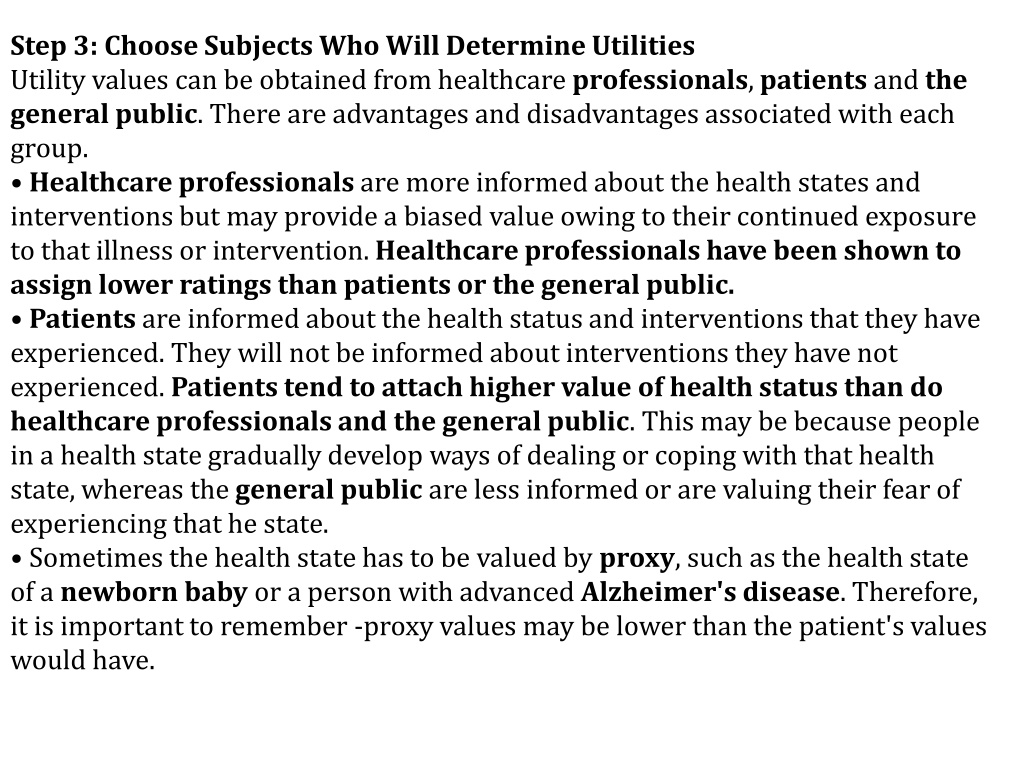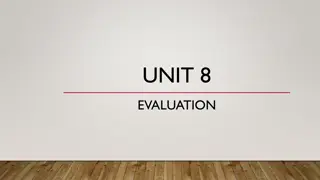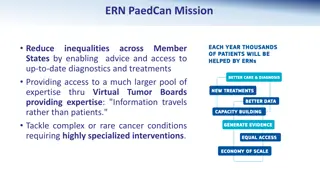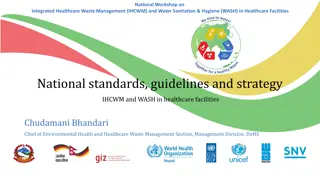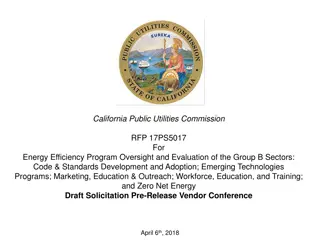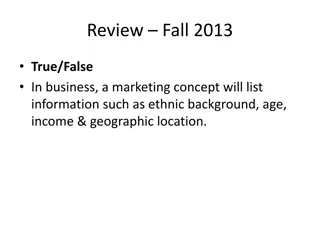Determining Utilities in Healthcare Evaluation
Health professionals, patients, and the public play roles in determining utility values for healthcare decisions. Considerations include bias, experience, and valuation methods. Economic evaluations, such as cost-effectiveness analyses, help compare treatment options based on quality-adjusted life years (QALYs).
Download Presentation

Please find below an Image/Link to download the presentation.
The content on the website is provided AS IS for your information and personal use only. It may not be sold, licensed, or shared on other websites without obtaining consent from the author.If you encounter any issues during the download, it is possible that the publisher has removed the file from their server.
You are allowed to download the files provided on this website for personal or commercial use, subject to the condition that they are used lawfully. All files are the property of their respective owners.
The content on the website is provided AS IS for your information and personal use only. It may not be sold, licensed, or shared on other websites without obtaining consent from the author.
E N D
Presentation Transcript
Step 3: Choose Subjects Who Will Determine Utilities Utility values can be obtained from healthcare professionals, patients and the general public. There are advantages and disadvantages associated with each group. Healthcare professionals are more informed about the health states and interventions but may provide a biased value owing to their continued exposure to that illness or intervention. Healthcare professionals have been shown to assign lower ratings than patients or the general public. Patients are informed about the health status and interventions that they have experienced. They will not be informed about interventions they have not experienced. Patients tend to attach higher value of health status than do healthcare professionals and the general public. This may be because people in a health state gradually develop ways of dealing or coping with that health state, whereas the general public are less informed or are valuing their fear of experiencing that he state. Sometimes the health state has to be valued by proxy, such as the health state of a newborn baby or a person with advanced Alzheimer's disease. Therefore, it is important to remember -proxy values may be lower than the patient's values would have.
Step 4. Multiply Utilities by the Length of Life for Each Option to Obtain QALYs In Table 6.1, we compare two treatment options, drug A and drug B. Although drug B extends the person s life for more years, the quality of life for those years is lower than with drug A. If a CEA were conducted, option B would be relatively cost-effective at an incremental cost per year of life of $5,000. If the quality of those years is incorporated into the equation by calculating QALYs, option A becomes dominant in that it costs less and provides a better outcome (more QALYs).
WORKED EXAMPLE 6.1 (ex: 5.2 contin) Economic evaluation of management of anaemia in haemodialysis patients: Patients with chronic renal failure who are on haemodialysis suffer from profound anaemia, which is often extremely debilitating. This is due to a reduction in the production of erythropoietin in these patients, and loss of blood during haemodialysis. Historically, these patients have been managed by the use of blood transfusions. Now, synthetic erythropoietin is available. It is considered to be highly effective, but is very expensive. So the alternatives are to either give erythropoietin or to give blood transfusions when the patient's "haemoglobin level is below 8g/dl.
1. What is the difference in cost between the two alternatives for the 1000 patients? 2,419,100. 2. What is the difference in utility production of the two alternatives, i.e. how many extra QALYs are produced by erythropoietin per year of treatment, for the 1000 patients? Change in utility = 0.80 - 0.75 = 0.05 QALYs per patient per annum = 50 QALYs per 1000 patients per annum. Figure 6.1 illustrates the difference in utility production for the two alternatives.
Figure 6.2 Cost-effectiveness plane for erythropoietin Vs blood transfusions
Results from a study suggest that the practice will have cost reductions and the patients will have improved outcomes (Table 6.1)
The practice has to decide whether to reduce emergency admissions due to asthma by 10 a year and save 1,000, or reduce emergency admissions due to chest pain by 25 a year at no change in costs to the practice. How can the GP objectively compare and choose between improving the health of asthma and IHD patients?
Groups A and B elicit utility values from the 200 asthma and 250 IHD patients. Time trade-off was used to elicit the utility values and these were used to calculate QALYs. The groups obtain the following results: The results refer to a 1-year period. The asthma patients improved their quality of life per year by 0.10 QALYs each. The IHD patients improved their quality of life per year by 0.15 QALYs each. Incremental cost-effectiveness ratio (ICER): Asthma patients IHD patients Mean QALYs before intervention 0.75 0.60 Mean QALYs after intervention 0.85 0.75 Incremental QALY change caused by intervention 0.10 0.15
If the GP practice funds the IHD service it will cost them 1,000 per year more than the asthma service, but they will obtain 17.5 more QALYs for their patients.
EXERCISE 1: Calculating a cost per QALY: Several treatments exist to treat fungal toenail infections. Four oral medicines used are drugs A, B, C and D. The table below shows the costs ( ) associated with treating one patient with each of these four treatments: Drug A Drug B Drug C Drug D Total costs ( ) 1,301 1,503 1,570 1,200 You then find some evidence to suggest that two of these agents have differing effects on patients' quality of life owing to difference in their side-effect profiles. This evidence is summarized below:
Agents Increase in QALYs per patient per year Drug C 0.10 Drug D 0.05
Which treatment will you recommend to your Trust, and why? Either could be recommended, depending on the driving force for the choice. Is cost containment most important? Then choose drug D. Is improved patient outcome most important? Then choose drug C.
